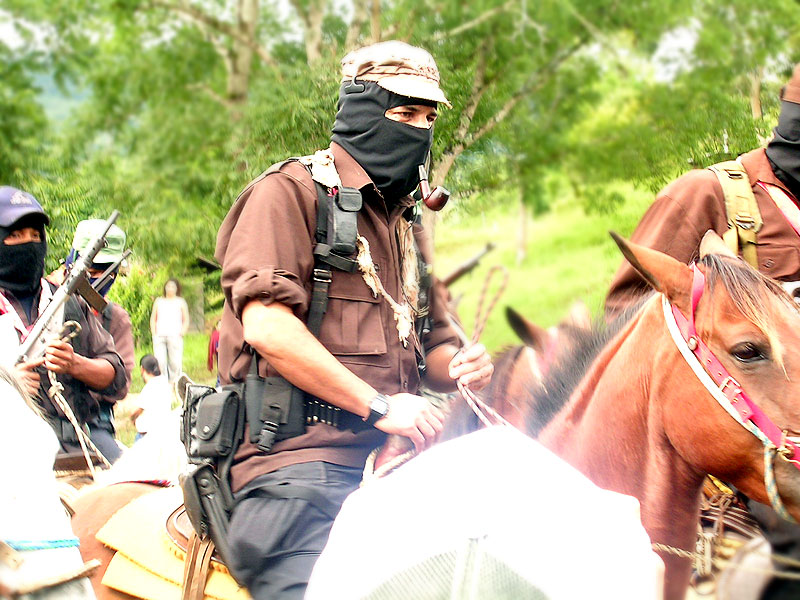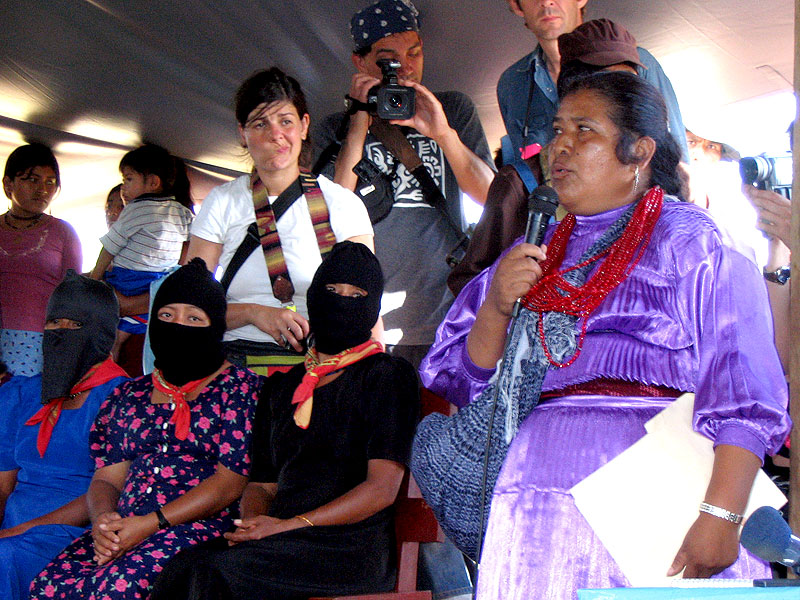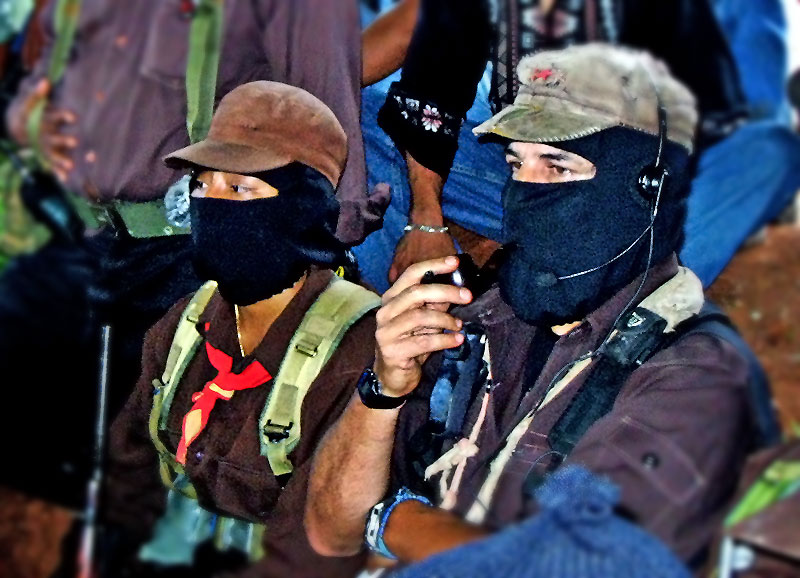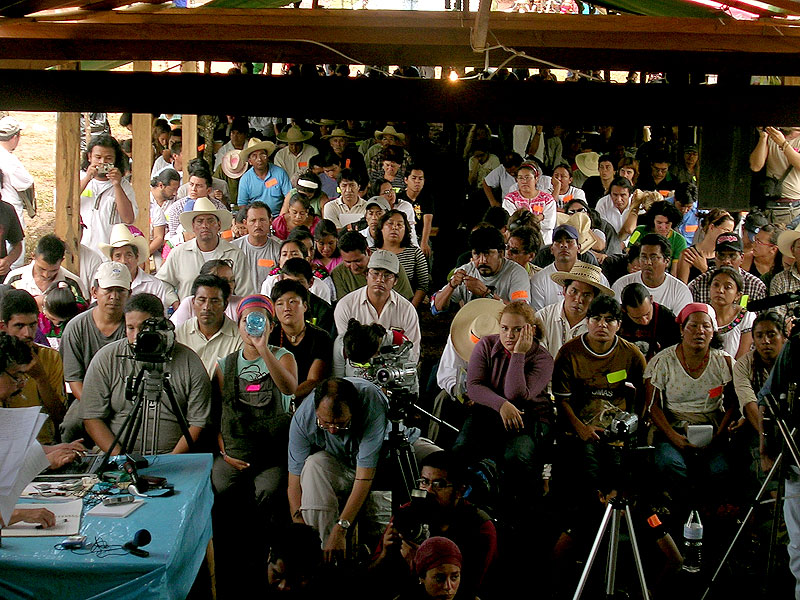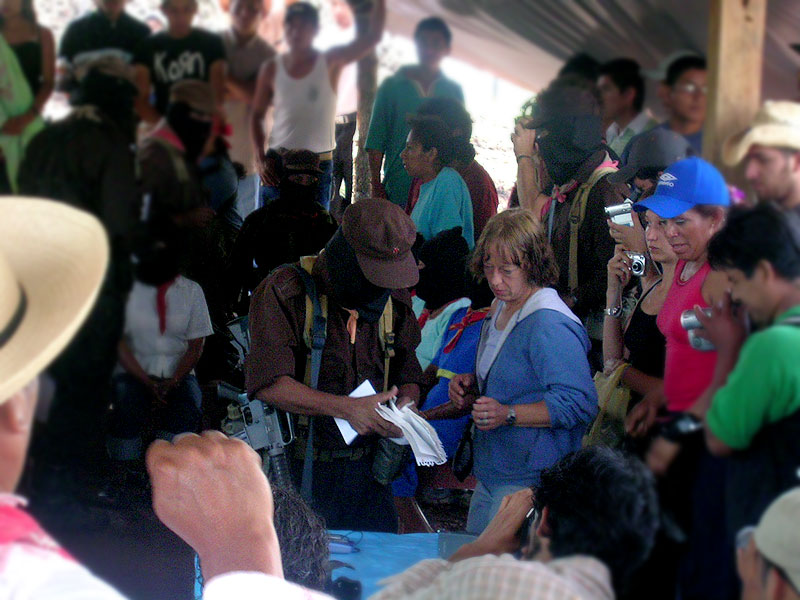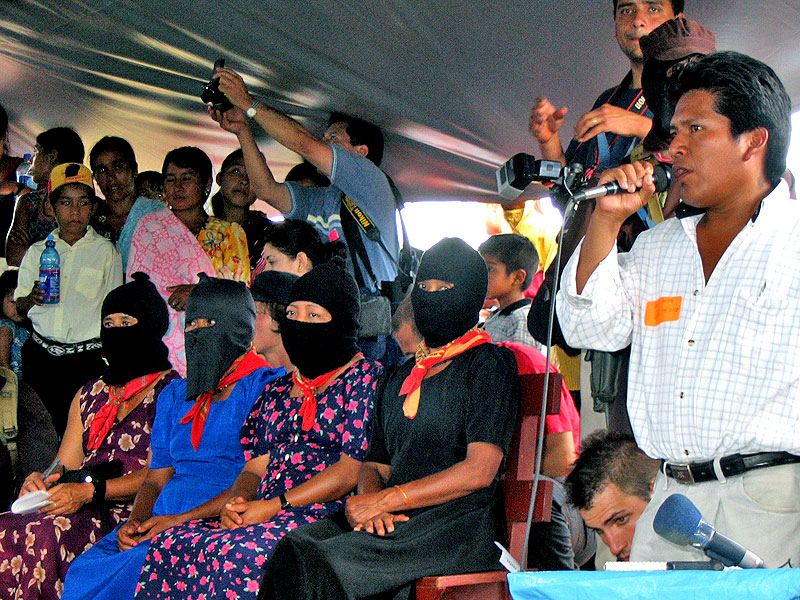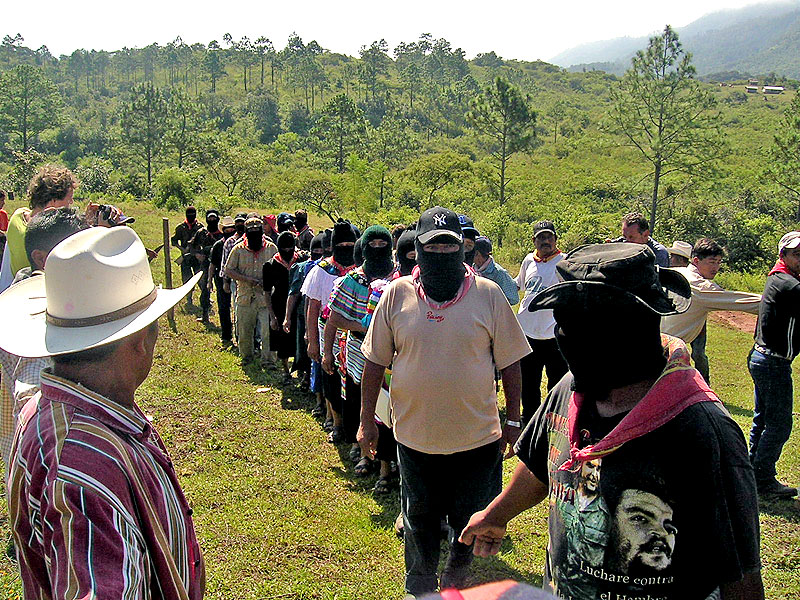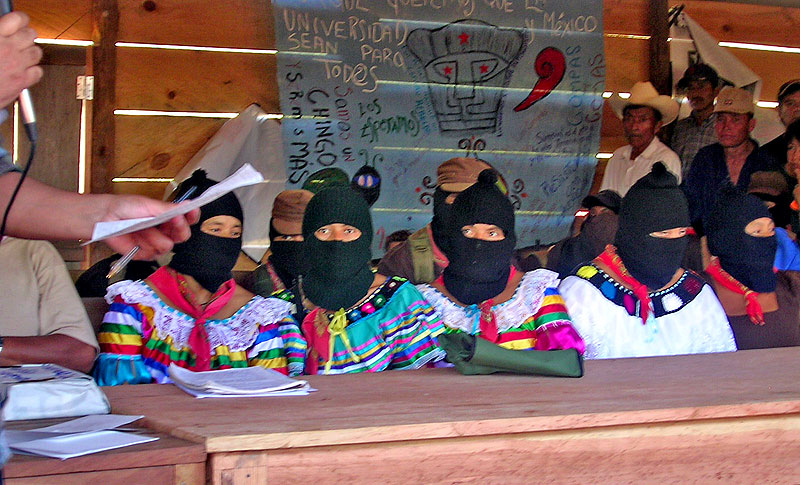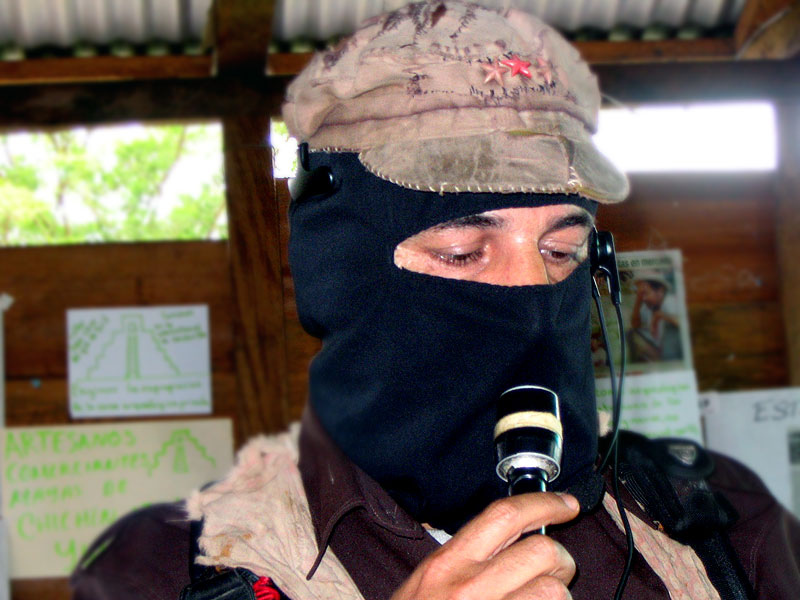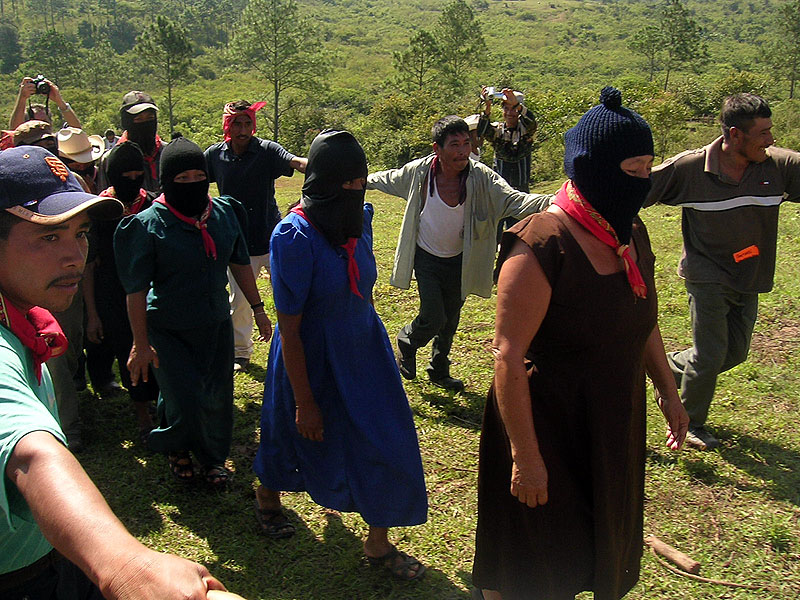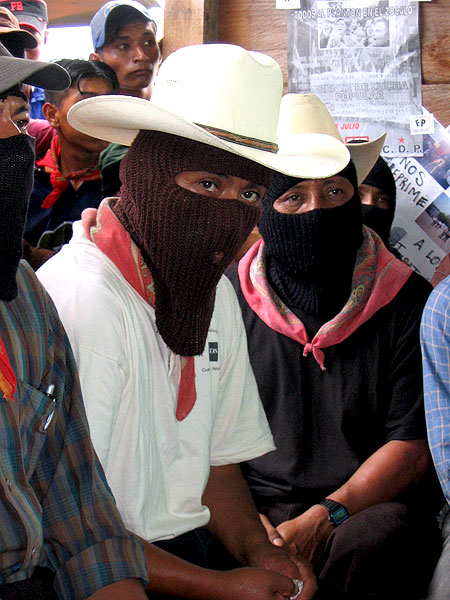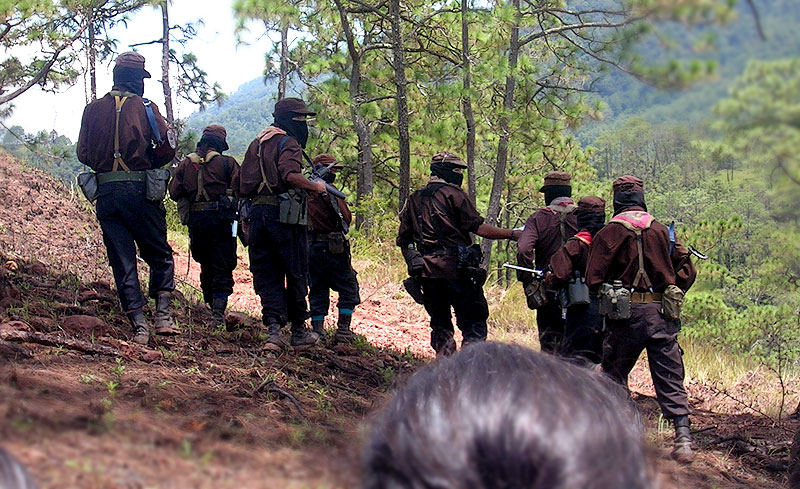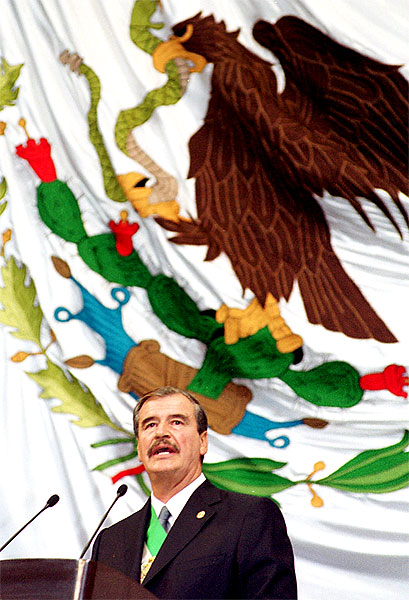“Because music is not composed of a single note, but rather of many, and dance is not simply the repetition of a single step to the point of exhaustion. Peace will therefore be an open concert of words and many views towards another geography…”
Another geography. EZLN. March 2003
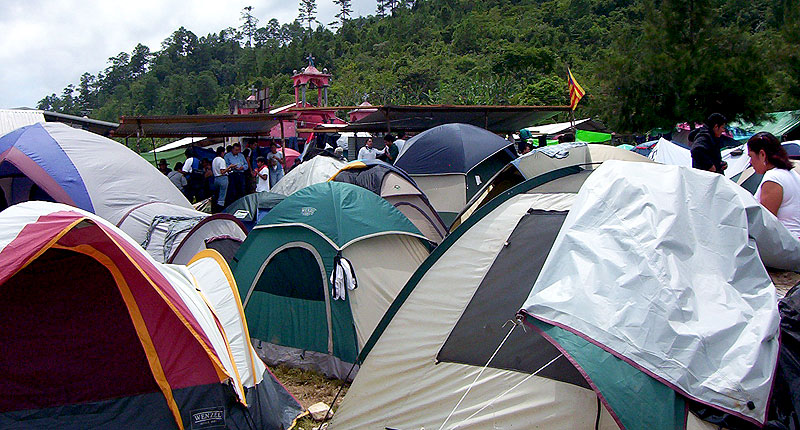 Marches, consultations, conventions and meetings have defined the political strategy of the Zapatista Army of National Liberation (EZLN) with their continual call for the participation of the civil society, nationally and internationally. The Sixth Declaration of the Selva Lacandona (“the Sexta,” published in June 2005) maintains coherence with this type of strategy and expresses, more than ever before, a recognition of the fact that the war taking place in Chiapas is the same war being waged in other parts of Mexico and throughout the world. Parallel to this recognition is the affirmation that a radical solution to the EZLN´s demands, and the armed conflict in Chiapas, must be based in a transformation of the neoliberal economic system.
Marches, consultations, conventions and meetings have defined the political strategy of the Zapatista Army of National Liberation (EZLN) with their continual call for the participation of the civil society, nationally and internationally. The Sixth Declaration of the Selva Lacandona (“the Sexta,” published in June 2005) maintains coherence with this type of strategy and expresses, more than ever before, a recognition of the fact that the war taking place in Chiapas is the same war being waged in other parts of Mexico and throughout the world. Parallel to this recognition is the affirmation that a radical solution to the EZLN´s demands, and the armed conflict in Chiapas, must be based in a transformation of the neoliberal economic system.
While this idea is not a new one, the Sexta does distinguish several differences vis-à-vis past initiatives. In the Sexta, the Zapatistas recognize the obstacles in advancing the process of creating change without being united or aligned with other movements of Mexico and the world where people are also constructing alternatives to neoliberal capitalism. To create such networks, the Zapatistas believe it is necessary that they meet these individuals and collectives that are also proposing new spaces for organizing, new relationships, and new proposals.
“The Sexta calls for a union of those who share this definition, with a challenge: another form of politics; with an objective: the construction of a national program for the leftist anti-capitalist struggle; and a destination: a new constitution, which is to say, a new contract for a new society. The Sexta proposes a mode: listening and learning. And the Sexta proposes how to do this listening and learning: with the ´other campaign´”
(EZLN, August 27, 2005)
The Sexta is a challenge to the imagination because it allows for the creation of “something else” through which to unite all of the struggles in all the corners of the world to create a new world where all of our differences can fit. The Other Campaign is the course proposed by the EZLN to achieve this unity.
The Selva Lacandona: an Experimental Laboratory for the Other Campaign
In August and September, the EZLN invited all those who adhere to the principles of the Sexta to share their opinions of the proposals and to meet each other. These meetings were a space for the discussion of what it means to be of the left, what the agenda of the left is, how the left should be structured, what sort of attitude to adopt with relation to the elections, and what concepts and slogans the Other Campaign should adopt.
The mode of “listening and learning” was put into action, serving as an example of the political exercise that many could learn from, especially the aspect of listening more and speaking less. In continuing its dialogue with the civil society, the EZLN offered to listen once again, however this time not from a podium but rather on the same level and without time limitations. Hundreds of people from around the nation traveled to spend a few days in the Selva Lacandona and be heard. In 2006, the EZLN will tour the nation to listen to all those who could not make the trip to the Selva, to understand their opinions and to continue developing the network among those adherents of the Sexta.
This methodology, devoid of logical frames, without blackboards or modern technology, is a return to the origin of everything: the word and the attentive ear. In a recuperation of Mayan knowledge, “the world begins to be born when one word and another word find each other and do not argue, rather they meet and reach an agreement because they have mutual respect, and they speak and they listen. And so there is agreement because the first word is not born alone, rather it is born with ears and it is with these ears, by listening, that the first words grow because they reach agreement, and the first words that found each other agreed and the first they thought the world and then they made it” (EZLN, August 13, 2005).
The “Other Campaign” in Electoral Times
The clear and convincing framework of the EZLN with respect to political parties, and especially the Revolutionary Democratic Party (PRD) has led individuals who were once aligned with the EZLN to detach themselves from the Other Campaign. The EZLN knew ahead of time that this proposal could risk a large number of the relationships they have created. They were conscious of the fact that part of the national and international society would not understand or share this proposal. With this in mind, one can reread the letter of farewell sent to the civil society by the EZLN, on June 21, 2005, shortly after declaring the Red Alert. The Sexta seeks to create a new cycle in the relationship of the EZLN to the civil society, opening up a new, more reciprocal and horizontal relation. This characteristic has been noted in several of the planning meetings. There has been a recognition of the ethical legitimacy of the EZLN in achieving such a broad and plural gathering.
Nevertheless, from the respectful position exhibited by the organizations that were present, there was great expression of criticism of the Zapatista leadership, primarily for their lack of support in moments of serious political repression. This was the case with the National Revolutionary Union of Euzkadi Workers (SNRTE) and the Popular Indigenous Council Ricardo Flores Magón (CIPRFM) of Oaxaca. Also, the feminist organizations of San Cristóbal de Las Casas demanded an explanation for the obstacles they felt in their work with Zapatista women. Many participants made it clear that they are not willing to receive orders or follow leaders. And the EZLN recognized the errors and poor choices they have made along the way, thanking the participants for their sincerity. They restated their commitment and loyalty to those who want to participate in the Campaign, where the EZLN will not claim to be the center nor the director.
The environment of each of the planning meetings was distinct, based on the organizations that were participating. The first meeting was with the political organizations of the left. The EZLN, recognizing its poor relationship with them and even its ignorance, praised the long-term work done by these organizations. In this session, there was great debate over whether or not to support the candidacy of López Obrador (PRD presidential candidate). The Popular Socialist Party of Mexico (PPSM), the Revolutionary Workers Party (PRT), the Socialist Workers Party (POS) and the Communist Party (Partido Comunista) affirmed the necessity of grassroots work, and someone agreed with the EZLN´s belief that the electoral venue has been exhausted. Similar to this session, the meeting with the social movements and organizations also included parts of the “traditional” left, with some of the major unions of Mexico reclaiming union autonomy.
The meeting with the indigenous groups was filled with emotion and rage. In this meeting, histories of resistance were once again united. The EZLN reiterated its indigenous identity and insisted in defending its voice within the Other Campaign. The EZLN asked that they be hosted in the indigenous territories during their national tour. Attending this meeting were comrades from the Caracol Autónomo de Zirahuén de Michoacán sharing their experiences in their struggle to defend the environment from the development of tourism. Also shared was the experience of the Indigenous Rights Center of Bachajón of Chiapas, which has been working to support the strengthening of the “Tzeltal judges” who resolve community conflicts according to their own traditional methods. Urban indigenous individuals also attended the meeting, highlighting the “Collective of Indigenous Peoples of Mexico City in Support of the Sexta,” which is composed of 17 organizations united by the Zapatista call to action.
Adding the differences of other groups, the meeting with the non-governmental organizations, collectives, and groups reflected the diversity of new forms of resistance against the neo-liberal system. This was the meeting of the young, or as one journalist wrote “the children of Zapatismo.” This group did not dedicate their time to discussion of the elections, rather they shared the day to day practices through which they aim to not reproduce the very system they reject. Radio Voladora, Radio Pacheco, Imagen MX or Indymedia-Chiapas among others, shared another form of freely informing about criticism, escaping the control of the major media outlets and putting technology to work for political and social movements. There were Jarocho sounds, Trova music in Tseltal and hip-hop, through which the young demonstrated their willingness to redefine their own cultures without being afraid of adopting new trends. A number of collectives reclaimed the diversity of sexual preferences, shattering the taboos that continue to prevail in Mexican society.
In the meeting with the individuals (of personal, family, or neighborhood titles), many shared their wounds from participating in the struggle. There was a sequence of life histories, personal journeys of self-discovery, and more than anything testimonies of how the EZLN, its theory and its practice, has appealed to thousands of Mexicans. There was a final preparatory meeting to incorporate the organizations, collectives, and individuals who could not attend.
The Other Campaign represents a review of those who were once participating but no longer do, as well as of those who had never approached the EZLN and are now including themselves in the Other Campaign because they feel that there is a place for them without requiring that they lose their autonomy or part of their identity.
The Plenary Session: The Plan of the Other Campaign
The First Plenary Session celebrated on the September 16 & 17 in the Caracol of La Garrucha represented a test of the Other Campaign. Many of the organizations that had participated separately in the previous days attended the Plenary Session. Each representative was given five minutes to express his or her opinion. The issues addressed included: the characteristics of the Other Campaign, the participants, the organizational structure, the space for differences, the position of the Other Campaign vis-à-vis other organizing efforts already in action at the national level addressing neo-liberal policies, and finally, the tasks at hand for those who were present. All of these issues remained open, so that the discussion might include the perspectives of those adherents of the Sexta who could not attend the First Plenary Session. Above all, this Plenary Session, with the presence of the EZLN commanders, had a very symbolic character, through which the Sexta and the Other Campaign were officially delivered and shared with all the adherents. The EZLN reiterated its assurance that they would walk together with the people with respect and equality. The EZLN also stated that the Other Campaign exists without a bank account and is solely supported by the people. With this, the Sexta and the Other Campaign stopped being a proposal solely of the EZLN and the committed organizations and individuals assumed an equal level of responsibility for this initiative.
At the Plenary Session, the EZLN commanders presented their “Plan” for the Other Campaign. The EZLN Commission of the Sexta will send the “Delegation Zero,” the Sub-commandante Insurgente Marcos to visit all the Mexican states between January and June 2006, closing this first phase on Saturday June 24 with a Plenary-Informative Session in Mexico City and the state of Mexico. The goals of this tour are to celebrate the state meetings of the Other Campaign, to organize the logistics of the next outing of the EZLN Commission of the Sexta, and to hold bilateral meetings with organizations. After the suspension of activities during the electoral period, the second outing will take place between September 2006 and March 2007. In this phase, a national delegation of the EZLN will travel throughout the nation, and regional and state delegations will remain in their respective regions or states to promote the Other Campaign. In April 2007 these delegations will be replaced by others, “and on and on, until we finish, that is, if we finish” (EZLN).
The announcement of Sub-comandante Marcos’ outing in the first phase has generated a great deal of excitement for some, and skepticism and bewilderment for others. With the latter there is fear that the media attention on Marcos could impair the essence of the project. Lieutenant Moisés´ words in the Plenary Session revealed the strategic symbolism of this decision. As they announced with the Red Alert, the commanders and their apparatus under recently revised direction, maintain themselves in a defensive position. Marcos will travel unarmed, demonstrating their willingness and preparedness to take risks. They announced that they have designated the necessary relief so that the tour will continue regardless of what happens. They also advised that those who want to walk with the Other Campaign must be prepared to confront repression and the media offensive that could arise, in the coming months, against the Campaign.
The Dead, the Prisoners, and the Disappeared Join the Other Campaign
The indigenous communities where the planning meetings were held have their own histories of struggle, which they shared at the opening of each meeting. The EZLN recalled that not so long ago those lands were “fincas” (plantations) where the indigenous peoples were treated like animals. At that time, they were not free to walk around the area unless they were working the land for a miserable wage. Those lands were “reclaimed” during the redistribution that followed the Zapatista uprising.
In remembering these histories, the contributions of several persons now deceased were recalled: Francisco Gómez (El Señor Ik) in the community of Juan Diego and the Subcommandante Insurgente Pedro in La Garrucha. They also recognized the dead of other struggles, with which they are in solidarity, as their own. They explained that to be united in struggle you must be united not only in the hope and in the rebellion but also in the pain. The student Noel Pavel was “present” as well as the human rights activist Digna Ochoa, the murdered women of Ciudad Juárez, and those killed in the counterinsurgency waged by paramilitaries in the northern zone of Chiapas. Felipe Arreaga, the campesino ecologist and political prisoner from Guerrero (who was freed on September 15), was also mentioned, as were the disappeared from the “Dirty War” of the 1970s.
For the EZLN this remembrance is a way to keep alive all those who have been disappeared, imprisoned, or killed for defending freedom and justice for all. In this sense, one of the first actions of the Other Campaign will be to hold a series of political and cultural activities from October 28- November 2nd to honor the dead, the disappeared, and the prisoners of the various struggles that exist as part of the Other Campaign. San Cristóbal de Las Casas, Chiapas, will be the center of this commemoration.
In Which Geographic Location Are You Situated?
The Sexta is composed of six parts: “1. What we are; 2. Where we are now; 3. How we see the world; 4. How we see our country, Mexico; 5. What we want to do; 6. How we are going to do it.” The Sexta invites everyone to ask themselves the same questions regarding whatever socio-political situation they live in. And while much is still lacking on the national level, on the international level the Sexta also involves us by leading us to question where we are situated and in which direction we want to move: “Those who live in the North do not do so in the geographic north, but rather in the Social North. This is to say, they are above. Those who live in the South are below. Geography has become simplified, there is an above and a below. The space of above is narrow and only a few fit. The space of below is so wide that it fits any part of the planet and it has space for all of humanity” (EZLN. Another Geography). The Sexta is proposed as an opportunity to articulate resistance not only in Mexico, but throughout the world. In the words of the Professor González Casanova, the Other Campaign could just as well be “the last chance for humanity.” The challenge is great and not only for the civil society of Mexico

